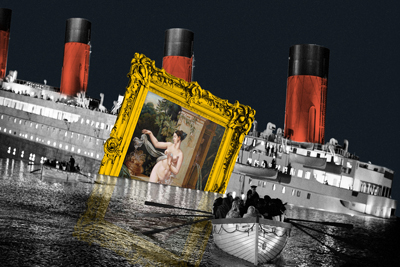
La Circassienne au Bain, a large neoclassical oil painting by Merry-Joseph Blondel, a French history painter, is closely associated with the sinking of the Titanic, the largest ocean liner at that time, in the early morning hours of 15 April 1912 in the North Atlantic Ocean.
Born on 25 July 1781 in Paris, Merry-Joseph Blondel secured a place in the studio of Baron Jean-Baptiste Regnault in 1801 for his talent in drawing, and within a year, won a number of medals and prizes for drawing. During those days, the annual Paris Salon was the ideal place art exhibition, where new artists were discovered, and established artists solidified their reputations. At the age of 22, Blondel submitted his oil painting Aeneas recuing his father from Troy to Salon at the Louvre, and won the prestigious Prix de Rome in 1802. Eventually, he became one of the esteemed neoclassic painters of France, and later in his life, he was mostly occupied with public commissions for painting and frescoes in famous museums, churches and palaces of the country, which included Louvre and the Palace of Versailles. Later in his life, he was awarded the prestigious Prix de Rome in 1802, and was bestowed with the Légion d’Honneur by Charles X of France two decades later.

La Circassienne au Bain, by Merry-Joseph Blondel, also known as Une Baigneuse in its early dates, was exhibited at the Paris Salon, in the Louvre museum, in November 1814, just when his career was beginning to take off. The painting depicted a nude Circassian woman stepping down into an antiquarian bath with her one foot, while the other balanced behind her resulting in a figure arranged in the traditional Greek contrapposto style.
While the bath is equipped with fountains, and surrounded by foliage, the woman looks elegant with her translucent pale complexions, regular features, slender waists, firm breasts, good posture, and an graceful demeanour. She is depicted in a gesture to remove the remaining transparent silk scarf that provides her with just a touch of modesty. However, despite her nudity, the woman’s hair remains in an elaborately braided up and her ears are garnished with appropriately dazzling baubles.
Although general public warmed to the work, the initial critical reception was mixed and almost muted. However, printed reproduction of the painting appeared in the French publicationAlmanach des Dames in 1823.

The whereabouts of the painting remained unknown for around a century until 1912 when Björnström-Steffansson, the 28- year-old son of a Swedish pulp baron, purchased it for unknown reason. He packed to take it with him to the United States where he is to continue his studies on a Swedish government scholarship. He booked a first-class ticket and boarded the Titanic on 10 April 1912, on its inaugural voyage, operated by the White Star Line. Tragically, the huge ship sank in the North Atlantic Ocean on 15 April, after striking an iceberg. Although Björnström-Steffansson was saved, La Circassienne au Bain drowned with the ship, and later gained notoriety when the owner of the painting filed US$ 100,000 compensation for the lost painting, the single largest claim in the six million dollar worth of claims. Probably, the claim was further settled for US$ 664,000 only.
Recently, in 2013, a British artist, under the pseudonym John Parker, extensively researched to reproduce a copy of La Circassienne au Bain, and his faithful reproduction was auctioned by Plymouth Auction Rooms in England for around US43, 500/
